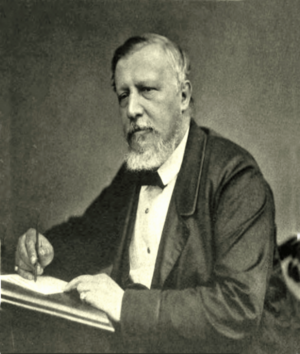Charles Tilstone Beke facts for kids
Charles Tilstone Beke (born October 10, 1800 – died July 31, 1874) was an English explorer, geographer, and a scholar who studied the Bible. He was known for his exciting journeys and his work on understanding ancient history and the geography of places like the Nile River valley.
Contents
Biography
Charles Beke was born in Stepney, a part of London. His father was a merchant, someone who bought and sold goods in the City of London. For a few years, Charles also worked in business.
Later, he decided to study law. He even worked as a lawyer for a while. But his real passion was studying history, geography, and different cultures.
Early Discoveries and Studies
In 1834, Beke published his first important book, called Origines Biblicae. This book tried to figure out the early history of humans using information from geology, which is the study of Earth's rocks and layers. This idea was new and caused some debate at the time. However, the University of Tübingen in Germany recognized his hard work and gave him a PhD degree.
Exploring the Nile and Ethiopia
From 1837 to 1838, Charles Beke worked as a British representative in Saxony, a region in Germany. After that, he spent most of his time studying geography, especially the Nile River valley in Africa.
With help from friends, he traveled to Ethiopia between 1840 and 1843. He explored areas like Gojjam and other southern regions that Europeans didn't know much about. One of his biggest achievements was being the first to accurately map the course of the Abay River, also known as the Blue Nile. He shared his discoveries in scientific magazines, especially the Journal of the Royal Geographical Society.
Later Expeditions and Recognition
When he returned to London, Beke went back to business. But he still spent all his free time on geography. In 1848, he planned an expedition to find the sources of the Nile River, starting from the coast near Zanzibar. The trip didn't achieve much, but Beke believed that the White Nile was the main branch of the river. Later explorers proved he was right!
In 1856, he tried to start trade with Ethiopia through a port called Massawa, but it wasn't successful. A few years later, in 1861-1862, he and his wife traveled to Syria and Palestine. They also went to Egypt to encourage trade with Central Africa and to help grow cotton in the Sudan.
In 1865, Beke tried to go to Ethiopia again. This time, he wanted to help free some British people who were held captive by Emperor Tewodros. He learned that the captives had been released and turned back. However, the emperor later re-arrested them. When a military expedition was sent to free them, Beke provided a lot of useful information. For his help to the government and his geographical research, he received money and a special pension.
In his 74th year, Beke took one last journey to Egypt. He wanted to find the exact location of Mount Sinai, a famous mountain mentioned in the Bible. He believed it was on the eastern side of the Gulf of Aqaba. His journey convinced him he was right, but his idea has not been widely accepted by others. Charles Beke died in Bromley, Kent.
Works and Achievements
Charles Beke wrote many books and papers. Some of his important works include An Essay on the Nile and its Tributaries (1847), The Sources of the Nile (1860), and The British Captives in Abyssinia (1865).
He was a member of the Royal Geographical Society. For his important contributions to understanding Ethiopia, he received a gold medal from them. He also received a gold medal from the French Société de Géographie. However, he later returned the French medal because of a disagreement with another explorer of Ethiopia, Antoine Thomson d'Abbadie.


